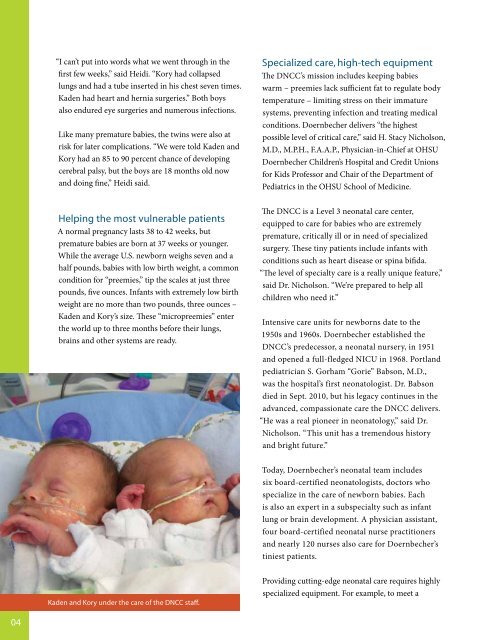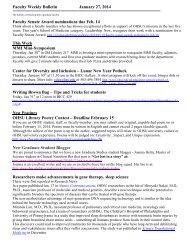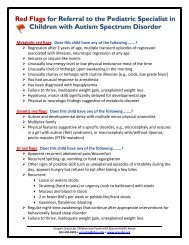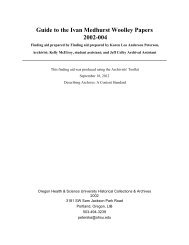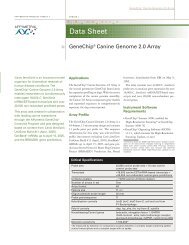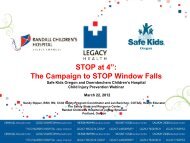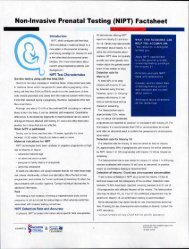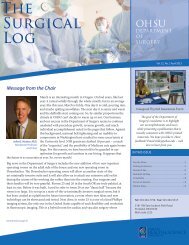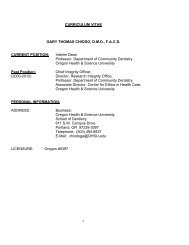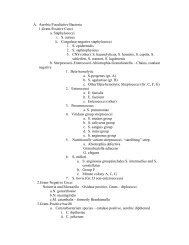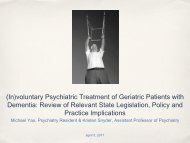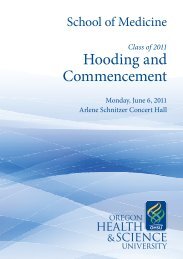Doernbecher neonatal Care Center Give Vulnerable PatientS The
Doernbecher neonatal Care Center Give Vulnerable PatientS The
Doernbecher neonatal Care Center Give Vulnerable PatientS The
You also want an ePaper? Increase the reach of your titles
YUMPU automatically turns print PDFs into web optimized ePapers that Google loves.
04<br />
“I can’t put into words what we went through in the<br />
first few weeks,” said Heidi. “Kory had collapsed<br />
lungs and had a tube inserted in his chest seven times.<br />
Kaden had heart and hernia surgeries.” Both boys<br />
also endured eye surgeries and numerous infections.<br />
Like many premature babies, the twins were also at<br />
risk for later complications. “We were told Kaden and<br />
Kory had an 85 to 90 percent chance of developing<br />
cerebral palsy, but the boys are 18 months old now<br />
and doing fine,” Heidi said.<br />
Helping the most vulnerable patients<br />
A normal pregnancy lasts 38 to 42 weeks, but<br />
premature babies are born at 37 weeks or younger.<br />
While the average U.S. newborn weighs seven and a<br />
half pounds, babies with low birth weight, a common<br />
condition for “preemies,” tip the scales at just three<br />
pounds, five ounces. Infants with extremely low birth<br />
weight are no more than two pounds, three ounces –<br />
Kaden and Kory’s size. <strong>The</strong>se “micropreemies” enter<br />
the world up to three months before their lungs,<br />
brains and other systems are ready.<br />
Kaden and Kory under the care of the DNCC staff.<br />
Specialized care, high-tech equipment<br />
<strong>The</strong> DNCC’s mission includes keeping babies<br />
warm – preemies lack sufficient fat to regulate body<br />
temperature – limiting stress on their immature<br />
systems, preventing infection and treating medical<br />
conditions. <strong>Doernbecher</strong> delivers “the highest<br />
possible level of critical care,” said H. Stacy Nicholson,<br />
M.D., M.P.H., F.A.A.P., Physician-in-Chief at OHSU<br />
<strong>Doernbecher</strong> Children’s Hospital and Credit Unions<br />
for Kids Professor and Chair of the Department of<br />
Pediatrics in the OHSU School of Medicine.<br />
<strong>The</strong> DNCC is a Level 3 <strong>neonatal</strong> care center,<br />
equipped to care for babies who are extremely<br />
premature, critically ill or in need of specialized<br />
surgery. <strong>The</strong>se tiny patients include infants with<br />
conditions such as heart disease or spina bifida.<br />
“<strong>The</strong> level of specialty care is a really unique feature,”<br />
said Dr. Nicholson. “We’re prepared to help all<br />
children who need it.”<br />
Intensive care units for newborns date to the<br />
1950s and 1960s. <strong>Doernbecher</strong> established the<br />
DNCC’s predecessor, a <strong>neonatal</strong> nursery, in 1951<br />
and opened a full-fledged NICU in 1968. Portland<br />
pediatrician S. Gorham “Gorie” Babson, M.D.,<br />
was the hospital’s first neonatologist. Dr. Babson<br />
died in Sept. 2010, but his legacy continues in the<br />
advanced, compassionate care the DNCC delivers.<br />
“He was a real pioneer in neonatology,” said Dr.<br />
Nicholson. “This unit has a tremendous history<br />
and bright future.”<br />
Today, <strong>Doernbecher</strong>’s <strong>neonatal</strong> team includes<br />
six board-certified neonatologists, doctors who<br />
specialize in the care of newborn babies. Each<br />
is also an expert in a subspecialty such as infant<br />
lung or brain development. A physician assistant,<br />
four board-certified <strong>neonatal</strong> nurse practitioners<br />
and nearly 120 nurses also care for <strong>Doernbecher</strong>’s<br />
tiniest patients.<br />
Providing cutting-edge <strong>neonatal</strong> care requires highly<br />
specialized equipment. For example, to meet a


